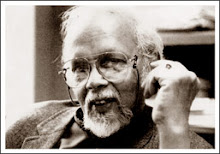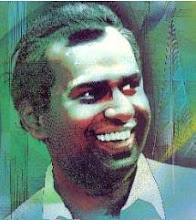Date:23/01/2011
Source: Sunday Observer
Chithrasena (26 January 1921-July 18 2005) who defined his era in his chosen field left an indelible footprints in the sand of time like many great personalities of humanity. His 90th birth anniversary is a seminal mark to look back on his trailblazing career in dancing with its overarching influence on Sri Lankan contemporary dancing. His greatest contribution to the field was the adaption of the traditional dance into modern theatre, thus infusing life into a dying tradition. Most of the prominent dancers and professionals in the field have either been disciples of the Chithrasena the guru or have substantially influenced by his practise.
 |
Maestro Chithrasena |
His death marked not only an end of an era which was dominated by cultural giants who had shaped the soul of independent Sri Lanka but also the emergence of a culturally alienated generation who have become victims of popular culture dominated by cheap movie stars from Hollywood and Bollywood.
His death occurred against the back drop of deteriorating indigenous arts and the sweeping wind of alienism in the spheres of culture, language and system of social values that have been held sacred for centuries. Sri Lankan dancing has been degraded to the status of being an ornamental art which is common at weddings, openings to beautify these occasions.
Dr. Radhika Coomaraswamy in an eulogy on Chithrasena says " To understand the importance of Chitrasena, we must place him in the context of history. Chitrasena belonged to that extraordinary generation of intellectuals and artists, whose genius was inspired by a rejection of colonialism and a commitment to national regeneration.
Today we take so much of this for granted. When we see a batik garment, do we for a moment thank Ena de Silva for reviving the batik industry? When we see Sinhala theatre, are we grateful to Sarathchandra?
When we see Sinhala films, do we always acknowledge Lester James Pieris? When we read the critical analysis of Tamil novels do we remember Professor Kailasapathy, and when we see Kandyan dance performed in a classical manner do we thank Chitrasena.?This generation gave us back our traditions but within the context of a modern nation state.
What were the hallmarks of this generatio? Firstly, they came from bilingual backgrounds. How many of us know that Chitrasena was born Maurice Dias and that his father was more at home with Shakespeare than with the Asian arts?.
This bilingualism gave them access to the Sinhala heritage, but also to world civilization from which they would draw. Secondly there was a search for authenticity and a commitment to the revival of indigenous tradition.
In doing so they crossed class, caste and gender barriers in search of the art form. They felt that our traditions belonged to all of us and were open to all of us to enjoy and perform, much like Rukmini Devi, his counterpart in Tamil Nadu. For this boldness they often received jeers and hard looks because they were crossing feudal practices, but they persevered nevertheless.
They discovered, regenerated, and filled with new energy, art forms that were quietly dying during the period of colonization. This commitment to revival would have made them great national artists but they went beyond that.
They had a great deal of respect for other traditions, both within Sri Lanka and abroad. One part of my family was dedicated to carnatic music and bharata natyam, Chitrasena and Vajira forged close links with them, they would attend each others performance and I would sit back and watch as they engaged in an artistic give and take which to the untalented such as myself was an extraordinary experience. "
Tradition caught up in whirlwind of commercialism
One of the ground realities that Chithrasena had to face at the tail end of his career was the overarching influence of commercialism on traditional art forms. The collapse of the social order which regimented the traditional art forms in the form of caste system and a royal patronage, has adversely affected the proponents of traditional art forms.
 |
Maestro Chithrasena |
Though commercialism is to be blamed for the situation, other factors such as the dwindling audience for serious art and the absence of the culture of appreciating serious work of art have also contributed to the present crisis in dancing. Against this back drop, it is not an estrange phenomenon that dancing has rendered as a highly commercilised 'flash art' which is of momentary value.
Another factor that adversely affects contemporary dancing in Sri Lanka is the absence of informed criticism on dancing. This is, perhaps, due to the sheer lack of attention and recognition paid to dancing as a serious art form and also due to the gross ignorance on the part of a mushrooming fraternity of critics.
It should be mentioned here that though there had been a somewhat evolved culture of criticism with regard to literature, paintings and visual and performing arts, it was rare to see an informed criticism on dancing or a ballet.
Even the established critics were reluctant to make a commentary of a ballet owing, perhaps, to ignorance of language and idiom to describe ballet or the unrepentant acceptance of the widespread myth that dancing is an art for cheap entertainment. It is pity, however, that this callous disregard on the part of a fraternity of critics has, by and large, contributed to re-affirm the popular myth on dancing.
It should be mentioned that to revisit the Chitrasena's practice of dancing and his masterpieces, especially in the light of the present crisis in Sri Lankan dancing which has been relegated to as a cheap form of entertainment, appealing to raw senses.
One of the significant features of Chithrasena's practices was that his consideration of dancing not as a mere form of art which manifests Sri Lankan culture but an art capable of expressing one's inner-most soul. He stressed this fact in performances such as Nurthanjali and Navanjali which were adapted to traditional theatre.
Through his larger-than-life personality, Chithrasena has left indelible footprints in the arena of Sri Lankan dancing. Perhaps, he will be remembered by the posterity as a peerless pioneer who uplifted the Sri Lankan tradition of dancing from its status of being a ritual to a fully-fledged art form suitable for proscenium stage.
He not only introduced ballet to Sri Lankan theatre but was also the pioneering choreographer in Sri Lankan dancing.
He laid a firm foundation for dancing admixing new features to it, making it suitable even for an international audience. His stage personality has become a prototype for aspiring dancers and he created theatrical marvels in his monumental work, ballet Karadiya.
For instance, the dream scene in Karadiya is a fine example of creating theatrical marvels which are inherently linked to the work. Most of the scenes in ballets Nala Damayanthi and Shivaranga remind us of the mystic quality in Asian myths. On the other hand, Kinkini Kolama manifests visual features of old Sri Lankan folk theatre.
Dancing in a broader perspective is an art which portrays the material world, beauty and rhythmic movements of the body. It not only provides a fresh perspective of life for the dancer but also for the deserving audience.
The essence of dancing, irrespective of diverse traditions, lies in its ability to entertain the dancer through rhythmic movements of the body and to convey it to the audience as an expression of emotions.
It is in this light that we should appreciate Chithrasena and his trailblazing career in dancing. Chithrasena's practice would strike a delicate balance between two extremes of totally being materialistic and being spiritual, completely forgetting the existence of the body.

 Ballet in its original form is, somewhat, a strange medium to Sri Lankan audience which is used to watch plays full of dialogues.
Ballet in its original form is, somewhat, a strange medium to Sri Lankan audience which is used to watch plays full of dialogues. The influence of Indian dance drama was a marked characteristic in early Sri Lankan ballets. However, this was changed with Premakumara Epitawala" Sala Lihini Sandeshaya". It was closer to a musical drama than to a ballet.
The influence of Indian dance drama was a marked characteristic in early Sri Lankan ballets. However, this was changed with Premakumara Epitawala" Sala Lihini Sandeshaya". It was closer to a musical drama than to a ballet.

































